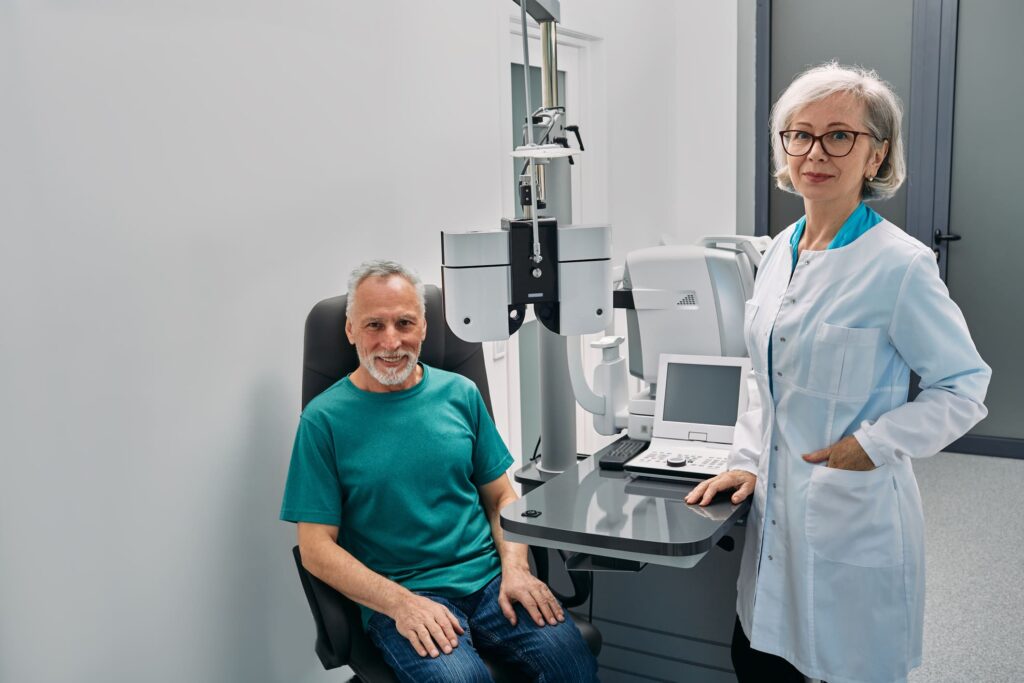Know how AMD is diagnosed and what eye doctors look for so that you and your loved ones can take a proactive, preventative approach.
When it comes to age-related macular degeneration (AMD), early detection and diagnosis are very important, as prompt care and treatment for AMD can result in better eye health outcomes for people living with the condition. Read on to learn more about AMD, its most common symptoms, how the condition is diagnosed, and how to take a preventative and proactive approach.
The impact of AMD on central vision and daily life
AMD is a progressive eye disease that affects central vision as a result of waste build-up at the centre part of the back of the eye, which is called the macula.[1] While AMD does not lead to age-related blindness (as eye conditions like cataracts and glaucoma may), it’s a major cause of age-related vision loss – in fact, it’s the leading cause of vision loss amongst people 50 years or older.[2] The macula is responsible for the detailed vision that’s required for daily activities such as reading, driving and recognizing people’s faces.[1] When it is damaged – as in people who have AMD – it can cause a significant impact on one’s quality of life.

Types of AMD: Differences between Dry and Wet forms
There are two types of AMD: dry AMD and wet AMD. Dry AMD is the most common form of AMD, accounting for about 80 per cent to 90 per cent of all cases.[1],[2] With dry AMD, patients will notice their central vision deteriorating over time, with their symptoms getting slowly and progressively worse.[2] Dry AMD can turn into wet AMD at any time,[1] which it does in about 10 per cent of individuals.[3] Wet AMD is a more serious form of macular degeneration, with symptoms progressing rapidly.[1]
Recognizing the symptoms of AMD: From early signs to advanced stages
The most common symptoms of AMD typically only present themselves once the disease has progressed to a certain degree, as in its early stages, AMD is often symptom-free.[1] Since dry AMD progresses slowly, patients may not initially be aware that they have the condition or any issues at all with their eyes or vision.
As such, regular visits to the eye doctor are incredibly important, as an eye exam can bring attention to early AMD much sooner, enabling earlier care and treatment. Once the condition has progressed, symptoms will appear – most notably blurred central vision, which will be more apparent when patients are performing tasks that require seeing finer details, such as reading.[1]
As the condition progresses even further, symptoms can include a bigger blurred area in one’s central field of vision that interferes with various activities of life such as driving.[1] Other common symptoms of AMD include straight lines appearing wavy or distorted, and dark spots or missing areas in their vision.[1] Untreated, late-stage AMD can result in a complete loss of central detailed vision.[1]

Diagnosing AMD: What to expect during an eye exam
AMD is most often diagnosed during a routine eye exam with your optometrist. As noted above, early signs of AMD can be found during a routine eye exam even if the patient hasn’t yet noticed any symptoms.[1] During an eye exam, optometrists use a special microscope to look directly onto the back of the person’s eye, which is where signs of AMD may be present.[1] They will be on the lookout for a build-up of a yellowish deposit called drusen, which indicates the first stages of the macula’s deterioration.[3]
Managing AMD: Tools for detection, prevention, and treatment options
Amsler grids and visual field tests are tools that can help to detect the extent of the vision loss.[1] The Amsler grid, which is a simple visual tool consisting of a square containing a grid pattern and a dot in the middle, can also be used at home to help people detect any changes or distortions in their vision.[2]
Maintaining a regular eye exam schedule will help to ensure that if you’re affected by AMD, your eye doctor will catch it earlier, leading to earlier care and treatment. There are steps that patients can take to reduce the risk of early-stage dry AMD progressing, including monitoring changes in their vision, following a healthy lifestyle, eating a balanced diet, exercising regularly and quitting smoking.[3]
Treatment is also available to reduce the vision impairment that accompanies dry AMD. MacuMira Vision Therapy is the only clinically-approved treatment for early-stage dry AMD in Canada. It uses non-invasive eyelid surface neurostimulation to deliver a patented microcurrent through patients’ closed eyes, helping to restore visual acuity, as demonstrated in a clinical study.
Take action and make an appointment with your eye doctor today to stay on top of your vision care.
Disclaimer: Always speak to your primary health care provider and/or eye care provider before making any changes to your lifestyle, activities or diet.




